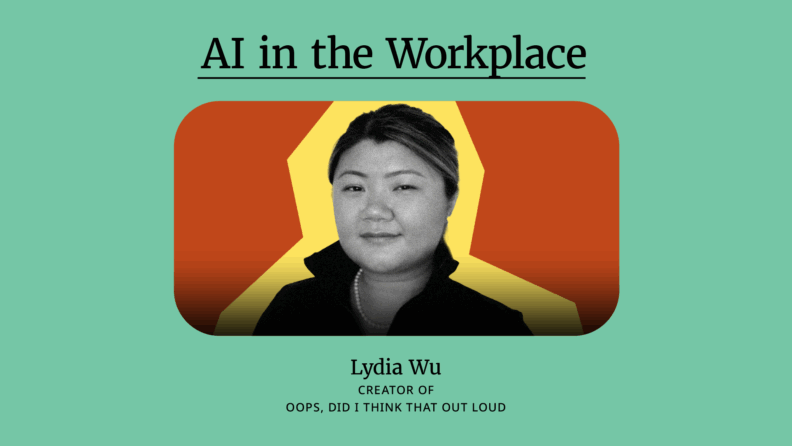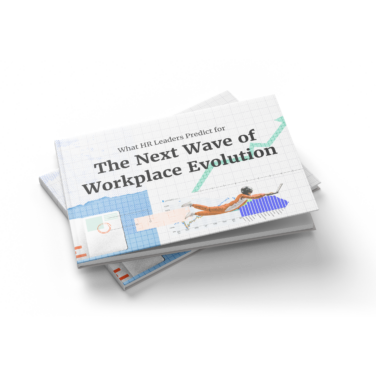Lydia Wu is the creator of Oops, Did I Think That Out Loud. As someone who reviews HR tech for a living, she argues that HR professionals need to stop evaluating AI tools like they did SaaS tools in the past.
According to Lydia, this moment of transformation demands that we become tech-savvy and understand the inner workings of our tools before we adopt them into our organizations.
We caught up with Lydia to find out how leaders can choose the right tech and integrate it effectively. Here's what she told us.
The Intersection of HR and AI Technology in the Workplace
I consider myself an industry observer, influencer, and educator. I am the founder and creator behind Oops, Did I Think That Out Loud, a platform dedicated to candid conversations on the intersection of HR and technology.
The platform was born two years ago when I was still working in corporate HR. I realized that there are a lot of what I would call "traumatized HR buyers" in the market. These are people who have, for one reason or another, had very bad experiences with HR technology.
There are some really, really brilliant vendors out there who have maybe spent a little too much money on their product development and engineering, but not enough money on the marketing side of things. So, for me, it just became a goal over time to connect the HR buyers to truly brilliant solutions that are actually designed to solve problems without all of the frills.
Beyond that, my career has spanned HR tech product development, people strategy, and large-scale HR transformations. I have reviewed over 800 HR tech solutions, managed a $40 million HR portfolio, and led the hands-on implementation of 60+ technology solutions. And I have worked with organizations of all sizes—from high-growth startups to Fortune 500 enterprises—helping them navigate the complex world of HR technology.
Why HR Leaders Must Become More Tech-Savvy in the AI Era
I think how HR has viewed, interacted with, and selected technology is changing rapidly in a world with AI. We have to buy tools differently.
Back in the traditional cloud SaaS days, you would typically assess the technology based on user requirements, then you'd see a demo and decide whether the tool was able to fulfill your user requirements. Simple.
That's not the case anymore. The digital components and layers needed to create AI tools are much more complex than previous versions of HR software technology — not all vendors have the ability to store and process their own data, nor do they have the ability to train their own AI models. This means that they have to contract 3rd party providers for their own technology infrastructure.
From an HR buyer's perspective, this adds more complexity and risk to data protection and security, as you may not always know who is handling your organizational data or where they are processing it.
Because of this, the backend layer of the technology, which is really the intelligence that powers the platform, also needs to be evaluated.
How To Evaluate AI Tools for HR Before Implementation
To do this, you first need to understand the purpose of a tool and match it to your business problems.
- Automation-based AI automates existing processes. It's good for when the business just needs to do something faster and cleaner.
- Assistive-AI helps people complete workflows. It's good for when you want to help your organization do things more consistently.
- Predictive AI predicts outcomes. It's good for when you want to understand patterns and prevent risks.
- Adaptive AI provides personalized experiences by adapting to individuals. It's good for when you need to scale culture and growth.
Once you've got a match, I recommend asking three questions of the software provider — and seeing if they are willing to answer:
- Between inputting my organizational data and receiving the output, where does my data go, who is handling it, and where does it get processed?
- What do you use as your backend LLM?
- What additional training does your model receive, and how is that training done?
How HR Professionals Can Build AI Literacy
It's also more important for HR professionals to get much more educated and up to speed on the variety of AI-enabled backends out there.
How do you get more educated? By following me, LOL. Joking aside, there are a few things you can do:
- Get curious. Just because something sounds technical doesn't mean ChatGPT can't break it down into easier-to-understand components.
- Don't be afraid to ask questions. Good technology solution partners are always willing to play the role of an educator. If your questions go unanswered, that says a lot about the solution.
- Talk about it. By sharing your challenges and best practices in smaller communities, you can get a much more holistic perspective from their peers and connect with those with similar experiences.
- Get your hands dirty. You cannot learn AI by studying theory and concepts online. You have to experience it hands-on to really understand it.
Why HR Leaders Must Revisit Workflows Before Adding AI
But remember, AI is just another piece of technology. We are in the midst of a transformation, but we've seen these transformations many times in the past. AI is just a different piece of technology that is enabling the transformation.
Some fundamental principles that have been used in previous transformations will still apply in this case. Just because it's a new technology doesn't mean that we have to throw out everything we know. We still need to be able to:
- Understand and diagnose current processes
- Define what value generation looks like for the business
- And collaborate with other stakeholders across different functions and work together as one to catapult the business into the future.
I think a lot of people are skipping this first step of examining the current status and truly understanding how the business operates at a workflow level — and why certain steps of the workflow are the way they are.
If you're a leader who is looking to transform an organization with AI, but who doesn't feel they know enough about it, I'd say it's time to go back to the basics. Understand how the current work is done before you attempt to re-engineer the future of work. Then, find opportunities within those workflows. And work within your organization's culture to execute the transformation.
Redefining Business Value and ROI in the AI Era
It's not just how the organization works; we also need to revisit how we generate value.
Previously, when we built business cases and created ROI calculations, we assumed an incredibly linear path between the actions and the results. For example, when we adopted a digital platform, we assumed that there would be efficiencies gained, whether it was from workforce reallocation or an overall reduction in spending.
However, with AI, the path to ROI is not as linear.
For example, when HR adopts certain AI solutions, you may not see a result directly on the HR team's overall PNL, but you're going to start noticing a difference in how your customer service, sales teams, etc. are performing in terms of the overall case closure rates and things along those lines.
So, in the AI era, it's more about the overall organization coming together and collaborating across functions to define and generate value for the entire organization, as opposed to each function going it alone, as we have seen in the past.
Why Businesses Can’t Treat the AI Era Like the Internet Era
We cannot run businesses in the AI era the same way we did in the Internet era. This technology demands a fundamental transformation in how we think about our business operations, our workflows, and our value generation.
We cannot run businesses in the AI era the same way we did in the Internet era. This technology demands a fundamental transformation in how we think about our business operations, our workflows, and our value generation.
That's the big disconnect. We are still looking for AI to create value on top of antiquated processes that were designed for the Internet era. And sure, slapping AI tools on top of existing processes will yield some value, but it's also creating challenges as to why companies cannot scale beyond a proof of concept or pilot into larger operations, because the technology was never designed for those old processes.
An AI-era transformation will require all of us to go back and look at the core of how our businesses are run. Then, we can change antiquated processes before applying AI on top of the core principles.
Building AI Literacy Through Bite-Sized, Hands-On HR Experiences
As I mentioned earlier, AI literacy comes through practice and hands-on, tactical learning. The entire workforce needs to be encouraged to get their hands dirty.
AI literacy comes through practice and hands-on, tactical learning. The entire workforce needs to be encouraged to get their hands dirty.
I've seen a few examples where this was done really well, and they all had one thing in common: They started small and made AI very tactical and impactful.
For example, one HR organization started a prompt-a-thon where the global HR team was brought together to come up with prompts, test them out in a real-life setting, and then the best prompts were collated into a prompt library that the entire organization can now use.
Another example is an HR team that encourages each other to think about how they use AI in their personal lives and share best practices from those experiences. From there, they try to figure out how those can be applied to their professional settings.
It's important to remember that HR teams don't have to become AI experts overnight. Comfort with AI comes from gradual and bite-sized experiences and practice.
The HR Operating Model Will Change Within 12 Months
If we look back in time at the HR function since the 1970s and 80s, the functional structure of HR really hasn't changed. I mean, we use different names—recruiting, talent acquisition, operational services, or shared services—but the reality is that the work is done in various functional silos.
But AI technology is about to change the HR operating model — within the next 9-12 months.
To truly realize the value and benefit of AI, we need to reorganize how work is done in HR and break down the functional siloes. We have to put our focus on the end results.
Follow Along
You can educate yourself and follow Lydia's work on LinkedIn, YouTube, and Instagram. And don't miss Oops Did I Think That Out Loud.
More expert interviews to come on People Managing People!



